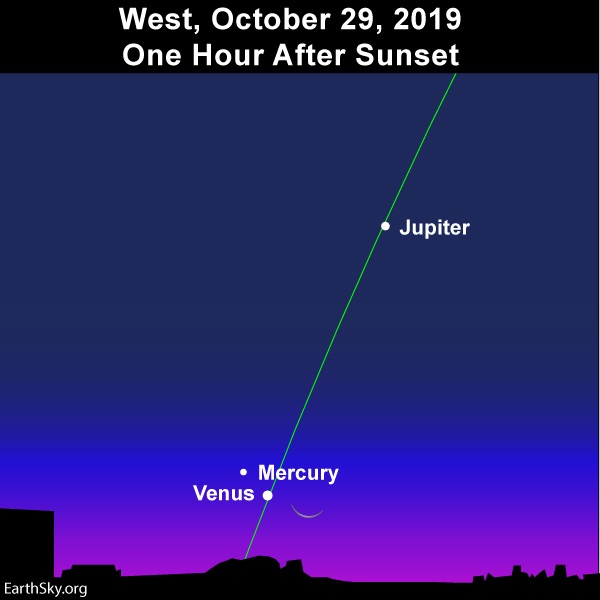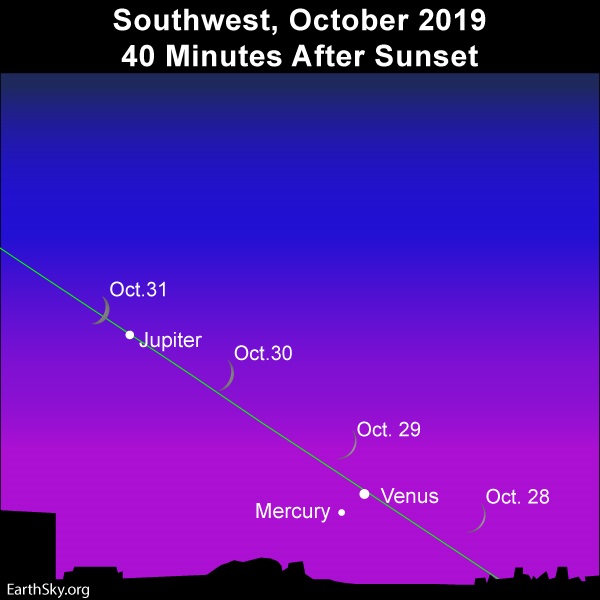
Have you seen Venus yet? And will you also see fainter Mercury near Venus? Both are in the western twilight after sunset. But whether you’ll see them depends on how far north or south you are on Earth’s globe. If you live as far north as Anchorage, Alaska, the sun, Mercury and Venus set at nearly the same time in your sky, so you’re sure to miss the planets. But if you live as far south as New Zealand’s South Island, Mercury and Venus stay out well over two hours after sunset. From far-southern latitudes, your chance of spotting these worlds is about as good as it gets in October 2019. Northerly latitudes … not so much. But we know you love a challenge!
The featured sky chart at top is for mid-northern latitudes in the Northern Hemisphere. The sky chart below shows the sky scene for around 35 degrees south latitude. The steeper tilt of the ecliptic (green line on our sky charts) relative to the sunset horizon gives the Southern Hemisphere the advantage for viewing the evening planets. At this time of year, the ecliptic hits the horizon at a shallow angle at northerly latitudes. The solar system planets always reside on or near the ecliptic – Earth’s orbital plane projected onto the constellations of the zodiac.
EarthSky 2020 lunar calendars are available! They make great gifts. Order now. Going fast!

Contrast the tilt of the ecliptic above at temperate latitudes in the Southern Hemisphere, with the tilt of the ecliptic on the featured chart at top for mid-northern latitudes.
Dazzling Venus shines close to Mercury on the sky’s dome. So look first for Venus, then watch for Mercury to pop out later, with either the unaided eye or binoculars. You may catch Venus 1/2 hour or sooner after sundown, because Venus ranks as the third-brightest heavenly body, after the sun and moon, respectively. Although Mercury is easily as bright as a 1st-magnitude star, Venus now outshines Mercury by about 35 times. Mercury is slowly dimming by the day, so Venus will outshine Mercury by about 45 times near the end of the month.
We give the approximate setting times for Mercury and Venus for these next several days at various latitudes (presuming a level and unobstructed horizon):
35 degrees north latitude:
Mercury sets 1 hour after the sun
Venus sets 50 minutes after the sunEquator (0 degrees latitude):
Mercury sets 1 1/2 hours after the sun
Venus sets 1 hour after the sun35 degrees south latitude:
Mercury sets 2 hours after the sun
Venus sets 1 1/3 hours after the sunWant more precision for your part of the world? Visit TimeandDate.com.
Mercury is fairly easy to see in the northern tropics and the Southern Hemisphere for two reasons. First, Mercury is near its greatest elongation of 25 degrees east of the sun (October 20, 2019), which places Mercury in the western sky after sunset. Although the elongation of Mercury is the same for the world as a whole, the tilt of the ecliptic favors the northern tropics and the Southern Hemisphere.
Visit AstroPixels.com to know Mercury’s solar elongation for each day of the year
Spring sunsets find the ecliptic intersecting the horizon at a steep angle, whereas autumn sunsets find the ecliptic intersecting the horizon at a shallow angle. Because it’s spring in the Southern Hemisphere and autumn in the Northern Hemisphere, the Southern Hemisphere has the advantage for viewing the evening planets. Moreover, Mercury is south of the ecliptic, which adds that much more to the Southern Hemisphere’s advantage and the Northern Hemisphere’s disadvantage.
The lucky residents in the Southern Hemisphere and the northern tropics have a golden opportunity to spot Mercury near Venus in the evening sky from now until early November.
And, no matter where you are on Earth, a great time to watch for Mercury and Venus will be toward this month’s end – on or near October 29, 2019 – when the young moon passes through this part of the sky. Think photo opportunity! Here’s the Southern Hemisphere view:

Southern Hemisphere view. The moon joins up with Venus and Mercury around the end of this month. This chart shows an optimum Southern Hemisphere view, specifically, in this case, from Cape Town, Africa, at dusk October 29, 2019. If you live in the Northern Hemisphere, this sweep of the young moon past the planets will give you, too, a good opportunity to glimpse them. Read more.
And here’s the Northern Hemisphere view. Notice that the ecliptic – shown as a green line on our charts – makes a narrow angle with the western horizon in the evening. That’s why Venus and Mercury are so much harder to see from this hemisphere, this month.

Northern Hemisphere view. This chart is for North American mid-northern latitudes. Same planets, same sunset sky … but the narrower angle of the ecliptic makes the planets harder to see. Read more.
By the way, when Mercury goes back into the sun’s glare – and passes between the Earth and sun – it will cross directly in front of the sun, creating what’s called a transit of Mercury. Although much more common than transits of Venus, a transit of Mercury happens only 14 times in the 21st century (2001 to 2100). Read more about the Mercury transit on November 11, 2019.
Bottom line: The Southern Hemisphere enjoys a superb view of Mercury and Venus in October 2019. If you live at northerly latitudes, have binoculars handy!
from EarthSky https://ift.tt/2Ms9fsn

Have you seen Venus yet? And will you also see fainter Mercury near Venus? Both are in the western twilight after sunset. But whether you’ll see them depends on how far north or south you are on Earth’s globe. If you live as far north as Anchorage, Alaska, the sun, Mercury and Venus set at nearly the same time in your sky, so you’re sure to miss the planets. But if you live as far south as New Zealand’s South Island, Mercury and Venus stay out well over two hours after sunset. From far-southern latitudes, your chance of spotting these worlds is about as good as it gets in October 2019. Northerly latitudes … not so much. But we know you love a challenge!
The featured sky chart at top is for mid-northern latitudes in the Northern Hemisphere. The sky chart below shows the sky scene for around 35 degrees south latitude. The steeper tilt of the ecliptic (green line on our sky charts) relative to the sunset horizon gives the Southern Hemisphere the advantage for viewing the evening planets. At this time of year, the ecliptic hits the horizon at a shallow angle at northerly latitudes. The solar system planets always reside on or near the ecliptic – Earth’s orbital plane projected onto the constellations of the zodiac.
EarthSky 2020 lunar calendars are available! They make great gifts. Order now. Going fast!

Contrast the tilt of the ecliptic above at temperate latitudes in the Southern Hemisphere, with the tilt of the ecliptic on the featured chart at top for mid-northern latitudes.
Dazzling Venus shines close to Mercury on the sky’s dome. So look first for Venus, then watch for Mercury to pop out later, with either the unaided eye or binoculars. You may catch Venus 1/2 hour or sooner after sundown, because Venus ranks as the third-brightest heavenly body, after the sun and moon, respectively. Although Mercury is easily as bright as a 1st-magnitude star, Venus now outshines Mercury by about 35 times. Mercury is slowly dimming by the day, so Venus will outshine Mercury by about 45 times near the end of the month.
We give the approximate setting times for Mercury and Venus for these next several days at various latitudes (presuming a level and unobstructed horizon):
35 degrees north latitude:
Mercury sets 1 hour after the sun
Venus sets 50 minutes after the sunEquator (0 degrees latitude):
Mercury sets 1 1/2 hours after the sun
Venus sets 1 hour after the sun35 degrees south latitude:
Mercury sets 2 hours after the sun
Venus sets 1 1/3 hours after the sunWant more precision for your part of the world? Visit TimeandDate.com.
Mercury is fairly easy to see in the northern tropics and the Southern Hemisphere for two reasons. First, Mercury is near its greatest elongation of 25 degrees east of the sun (October 20, 2019), which places Mercury in the western sky after sunset. Although the elongation of Mercury is the same for the world as a whole, the tilt of the ecliptic favors the northern tropics and the Southern Hemisphere.
Visit AstroPixels.com to know Mercury’s solar elongation for each day of the year
Spring sunsets find the ecliptic intersecting the horizon at a steep angle, whereas autumn sunsets find the ecliptic intersecting the horizon at a shallow angle. Because it’s spring in the Southern Hemisphere and autumn in the Northern Hemisphere, the Southern Hemisphere has the advantage for viewing the evening planets. Moreover, Mercury is south of the ecliptic, which adds that much more to the Southern Hemisphere’s advantage and the Northern Hemisphere’s disadvantage.
The lucky residents in the Southern Hemisphere and the northern tropics have a golden opportunity to spot Mercury near Venus in the evening sky from now until early November.
And, no matter where you are on Earth, a great time to watch for Mercury and Venus will be toward this month’s end – on or near October 29, 2019 – when the young moon passes through this part of the sky. Think photo opportunity! Here’s the Southern Hemisphere view:

Southern Hemisphere view. The moon joins up with Venus and Mercury around the end of this month. This chart shows an optimum Southern Hemisphere view, specifically, in this case, from Cape Town, Africa, at dusk October 29, 2019. If you live in the Northern Hemisphere, this sweep of the young moon past the planets will give you, too, a good opportunity to glimpse them. Read more.
And here’s the Northern Hemisphere view. Notice that the ecliptic – shown as a green line on our charts – makes a narrow angle with the western horizon in the evening. That’s why Venus and Mercury are so much harder to see from this hemisphere, this month.

Northern Hemisphere view. This chart is for North American mid-northern latitudes. Same planets, same sunset sky … but the narrower angle of the ecliptic makes the planets harder to see. Read more.
By the way, when Mercury goes back into the sun’s glare – and passes between the Earth and sun – it will cross directly in front of the sun, creating what’s called a transit of Mercury. Although much more common than transits of Venus, a transit of Mercury happens only 14 times in the 21st century (2001 to 2100). Read more about the Mercury transit on November 11, 2019.
Bottom line: The Southern Hemisphere enjoys a superb view of Mercury and Venus in October 2019. If you live at northerly latitudes, have binoculars handy!
from EarthSky https://ift.tt/2Ms9fsn

Aucun commentaire:
Enregistrer un commentaire